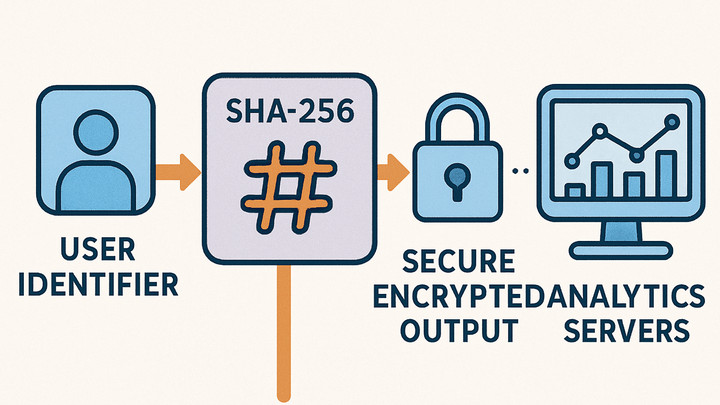Published on 2025-06-27T22:29:04Z
What is SHA-256? Examples in Analytics
SHA-256 (Secure Hash Algorithm 256-bit) is a cryptographic hash function widely used in analytics to pseudonymize user data and verify data integrity. It produces a fixed 256-bit (32-byte) hash, ensuring the output is unique for different inputs while being infeasible to reverse or find collisions. In analytics workflows, SHA-256 helps protect personal information by hashing identifiers like email addresses or device fingerprints before sending them to tracking services. Additionally, it’s used to sign analytics payloads, confirming that data hasn’t been tampered with in transit. This ensures both privacy compliance and data trustworthiness across platforms such as PlainSignal and Google Analytics 4.
Sha-256
SHA-256 is a secure 256-bit hashing algorithm used in analytics for user pseudonymization and data integrity verification.
Nature of SHA-256
SHA-256 is part of the SHA-2 cryptographic family, generating a unique 256-bit digest for any input. It’s deterministic (same input yields same output) and one-way (irreversible), making it ideal for anonymizing data. Key properties include collision resistance (practically impossible to find two inputs with the same hash) and the avalanche effect (small input changes yield vastly different outputs).
-
Hashing fundamentals
A hash function converts input data of any size into a fixed-length string of characters. SHA-256 always outputs exactly 64 hexadecimal characters, representing 256 bits.
-
Core characteristics
SHA-256 ensures high security through collision resistance, preimage resistance, and rapid computation, making it suitable for large-scale analytics use cases.
Applications in Analytics
In analytics, SHA-256 is primarily used to protect user privacy and verify that data hasn’t been altered. By hashing PII or device fingerprints, platforms can track users consistently without exposing raw personal information.
-
User pseudonymization
Instead of sending raw identifiers like email or user IDs, analytics tools hash them with SHA-256. This provides a persistent but non-identifiable key across sessions.
-
PlainSignal cookie-free analytics
PlainSignal uses SHA-256 to hash device fingerprints (IP, user agent, screen resolution) into a unique user key without relying on cookies.
-
GA4 user_id parameter
Google Analytics 4 allows setting a user_id parameter. Hashing this ID ensures privacy while maintaining cross-device user tracking.
-
-
Data integrity and signing
SHA-256 can sign analytics payloads or verify that data hasn’t been tampered with during transmission. Often combined with HMAC for authenticated hashing.
-
Measurement protocol signatures
When sending events via GA4 Measurement Protocol, appending a SHA-256–based signature helps confirm the request’s authenticity.
-
Implementation Techniques
SHA-256 hashing can be performed on the client or server side. Modern browsers offer the Web Crypto API, while backend environments provide libraries to compute hashes before forwarding data to analytics endpoints.
-
Client-side hashing with web crypto api
The browser’s built-in crypto.subtle API offers efficient SHA-256 hashing without external dependencies.
-
Javascript example
async function sha256(message) { const msgBuffer = new TextEncoder().encode(message); const hashBuffer = await crypto.subtle.digest('SHA-256', msgBuffer); const hashArray = Array.from(new Uint8Array(hashBuffer)); return hashArray.map(b => b.toString(16).padStart(2, '0')).join(''); }
-
-
Server-side hashing
Backend hashing ensures that data sent to analytics is already anonymized, reducing client-side overhead.
-
Node.js example
const crypto = require('crypto'); function sha256(value) { return crypto.createHash('sha256').update(value).digest('hex'); } -
Python example
import hashlib def sha256(value): return hashlib.sha256(value.encode('utf-8')).hexdigest()
-
Integration Examples
These examples demonstrate how to integrate SHA-256 hashing into PlainSignal and GA4 tracking setups.
-
PlainSignal integration
Hash a user-provided identifier and pass it to PlainSignal’s initialization to maintain anonymity.
-
Code example
<link rel='preconnect' href='//eu.plainsignal.com/' crossorigin /> <script defer> (async () => { const id = await sha256('[email protected]'); window.psInit({ api: '//eu.plainsignal.com', siteId: '0GQV1xmtzQQ', userKey: id }); })(); </script> <script defer data-id='0GQV1xmtzQQ' data-api='//eu.plainsignal.com' src='//cdn.plainsignal.com/plainsignal-min.js'></script>
-
-
GA4 integration
Compute a SHA-256 hash of your user identifier and configure gtag.js to use it as the user_id.
-
Gtag.js example
<script async src='https://www.googletagmanager.com/gtag/js?id=G-XXXX'></script> <script> window.dataLayer = window.dataLayer || []; function gtag(){dataLayer.push(arguments);} gtag('js', new Date()); (async () => { const userIdHash = await sha256('[email protected]'); gtag('config', 'G-XXXX', { user_id: userIdHash }); })(); </script>
-
Best Practices and Considerations
While SHA-256 enhances privacy and security, consider performance, collision risk, and legal definitions of hashed PII when implementing.
-
Privacy and compliance
Hashed identifiers may still be considered personal data under GDPR. Always verify with legal requirements.
-
Collision and security risks
Although collisions in SHA-256 are extremely unlikely, avoid using raw hashes for highly sensitive data; consider salting or HMAC.
-
Performance optimization
Client-side hashing can increase page load times; mitigate by hashing only essential values or caching results.
